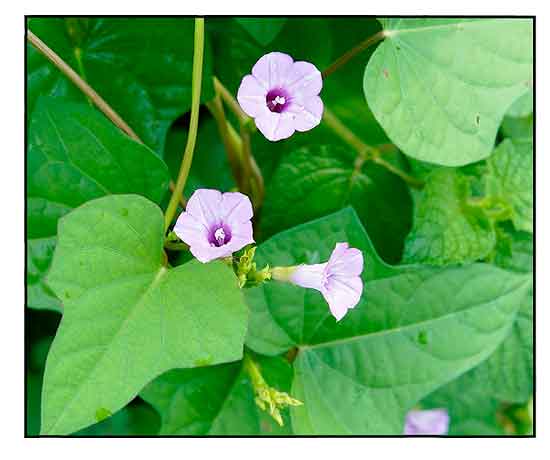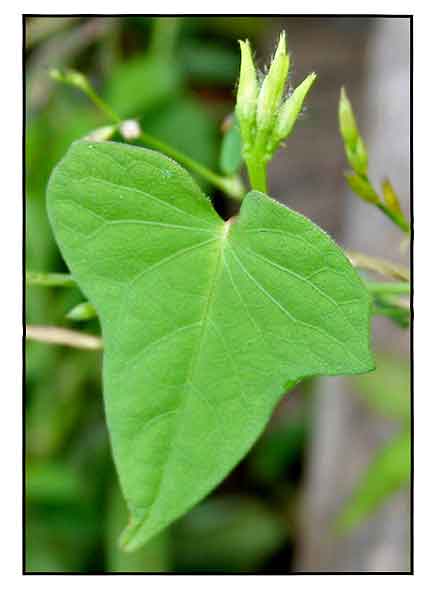
Family • Convolvulaceae
Baging-baging
Ipomoea triloba L.
THREE-LOBED MORNING GLORY / LITTLE BELL
Shan lie ye shu
| Scientific names | Common names |
| Amphione lobata Raf. | Aurora (Tag.) |
| Convolvulus heterophyllus Sesse & Moc. | Baging-baging (Tag.) |
| Convolvulus ipomoea Vell. | Bang-ba-ngao (Ilk.) |
| Convolvulus mariannensis (Choisy) Gaudich. ex Saff. | Kamkamote (La Union) |
| Convolvulus sloanei Spreng. | Karakamote (Tag.) |
| Convolvulus subquinquelobus Wood | Muti-muti (C.Bis.) |
| Convolvulus trilobus (L.) Desr. | Aiea morning glory (Engl.) |
| Ipomoea eustachiana Andersson | Little bell (Engl.) |
| Ipomoea galapagensis Andersson | Little bell morning glory (Engl.) |
| Ipomoea hirta M.Martens & Galleotti | Morning glory (Engl.) |
| Ipomoea krugii Urb. | Pink convolvulus (Engl.) |
| Ipomoea laxiflora H.J.Chowdhery & Debta | Three-lobed morning glory (Engl.) |
| Ipomoea mariannensis Choisy | Trilobed morning glory (Engl.) |
| Ipomoea parviflora Vahl | Wild potato (Engl.) |
| Ipomoea triloba L. | Wild slip (Engl.) |
| Ipomoea triloba var. eustachiana (Jacq.) Griseb. | |
| Ipomoea triloba var. genuina Meisn. | |
| Ipomoea triloba var. glaberrima Meisn. | |
| Ipomoea triloba var. quinqueloba Kuntze | |
| Ipomoea webbii Cout. | |
| Quamoclit eustachiana (Jacq.) G.Don | |
| Quamoclit triloba (L.) G.Don | |
| Ipomoea triloba is an accepted species. KEW: Plants of the World Online | |
| Other vernacular names |
| CHAMORRO: Fofegau, Fofgu, Fofgu-sabana, Nedgut, Netkort. |
| CHINA: Shan lie ye shu. |
| CUBA: Boniato marrullero. |
| FRANCE: Ipomee fleur rose. |
| GERMANY: Dreilappige, Trichterwinde. |
| HEBREW: Lefufit meshulleshet. |
| HINDI: Shakkaria, Ratalu. |
| JAPAN: Hoshiasagao. |
| MALAYSIA: Gegasing, Kangkong bulu. |
| PALAUAN: Torech. |
| SPAIN: Batatilla, Campanilla, Campanilla morada, Campanilla rosado, Churristate, Puyui. |
| THAILAND: Yaa dok khon. |
| VIETNAM: B[if]m ba th[uf]y. |
| YAPESE: Galli ngo boca roro. |
Botany Distribution
Properties Studies Availability |
April 2023
![]()
 |
| PHOTOS / ILLUSTRATIONS |
| IMAGE SOURCE: Photograph: Ipomoea triloba / Vengolis / CC by SA 4.0 / click on image to go to source page / Wikimedia Commons |
OTHER IMAGE SOURCE: Photograph: Ipomoea triloba / J M Garg / Creative Commons / click on image to go to source page / Useful Tropical Plants |
Additional
Sources and Suggested Readings |
• |
DOI: It is not uncommon for links on studies/sources to change. Copying and pasting the information on the search window or using the DOI (if available) will often redirect to the new link page. (Citing and Using a (DOI) Digital Object Identifier) |
| List of Understudied Philippine Medicinal Plants |
• |
 |



